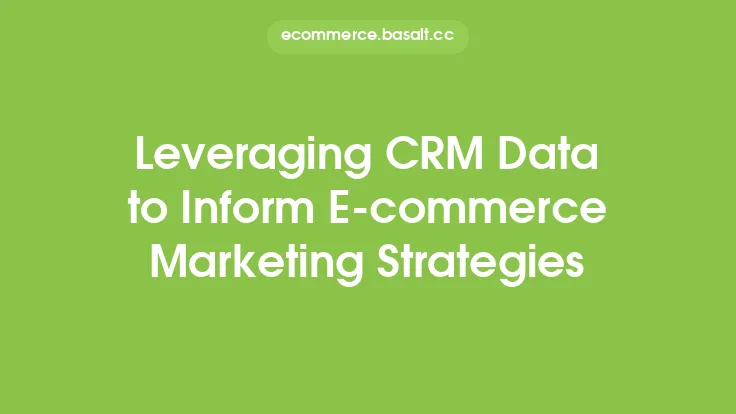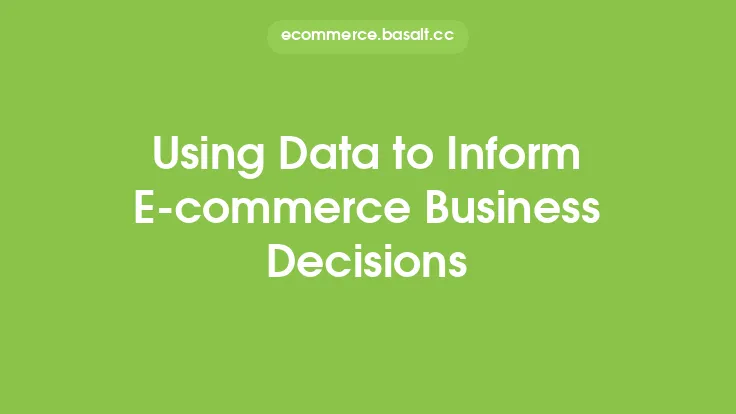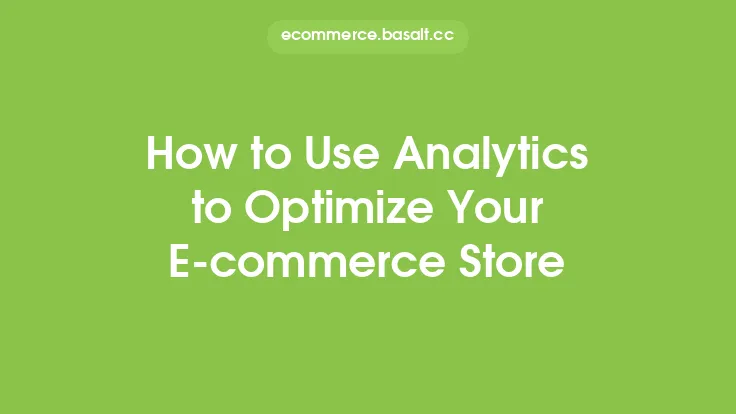In the world of e-commerce, data is the lifeblood that drives marketing strategies. With the vast amount of information available, it can be overwhelming to determine which data points to focus on and how to use them to inform marketing decisions. However, by leveraging data effectively, e-commerce businesses can gain a competitive edge, increase conversions, and drive revenue growth. In this article, we will explore the ways to use data to inform e-commerce marketing strategies, providing a comprehensive guide on how to collect, analyze, and apply data-driven insights to optimize marketing efforts.
Understanding E-commerce Data
E-commerce data encompasses a wide range of information, including customer demographics, browsing behavior, purchase history, and marketing campaign performance. This data can be categorized into two main types: quantitative and qualitative. Quantitative data includes numerical values such as sales, website traffic, and conversion rates, while qualitative data provides insights into customer behavior, preferences, and opinions. To make informed marketing decisions, it is essential to collect and analyze both types of data.
Collecting E-commerce Data
There are several ways to collect e-commerce data, including website analytics tools, customer relationship management (CRM) software, and social media listening tools. Website analytics tools, such as Google Analytics, provide insights into website traffic, browsing behavior, and conversion rates. CRM software, on the other hand, helps to manage customer interactions and provides valuable information on customer demographics, purchase history, and communication preferences. Social media listening tools enable businesses to monitor social media conversations, track brand mentions, and gauge customer sentiment.
Analyzing E-commerce Data
Once the data is collected, it needs to be analyzed to extract meaningful insights. This involves using statistical methods and data visualization techniques to identify trends, patterns, and correlations. Data analysis can help to answer questions such as: Which marketing channels drive the most conversions? What are the most popular products among customers? Which customer segments are most profitable? By analyzing e-commerce data, businesses can gain a deeper understanding of their customers, identify areas for improvement, and optimize their marketing strategies.
Applying Data-Driven Insights to Marketing Strategies
Data-driven insights can be applied to various aspects of e-commerce marketing, including product development, pricing, promotion, and customer experience. For example, data analysis can help to identify product gaps in the market, inform pricing decisions, and optimize marketing campaigns. By using data to inform marketing strategies, businesses can increase the effectiveness of their marketing efforts, improve customer engagement, and drive revenue growth.
Using Data to Inform Product Development
Data can be used to inform product development by analyzing customer behavior, preferences, and purchase history. For instance, data analysis can help to identify top-selling products, customer demographics, and browsing behavior. This information can be used to develop new products, improve existing ones, and create personalized product recommendations. By using data to inform product development, businesses can create products that meet customer needs, increase customer satisfaction, and drive sales.
Using Data to Inform Pricing Decisions
Data can also be used to inform pricing decisions by analyzing market trends, customer behavior, and competitor pricing. For example, data analysis can help to identify price elasticity, customer willingness to pay, and competitor pricing strategies. This information can be used to optimize pricing, improve profit margins, and increase revenue. By using data to inform pricing decisions, businesses can stay competitive, increase customer value, and drive revenue growth.
Using Data to Optimize Marketing Campaigns
Data can be used to optimize marketing campaigns by analyzing customer behavior, marketing channel performance, and campaign ROI. For instance, data analysis can help to identify the most effective marketing channels, customer segments, and campaign messaging. This information can be used to optimize marketing campaigns, improve customer engagement, and increase conversions. By using data to optimize marketing campaigns, businesses can increase the effectiveness of their marketing efforts, improve customer experience, and drive revenue growth.
Measuring the Effectiveness of Data-Driven Marketing Strategies
To measure the effectiveness of data-driven marketing strategies, businesses need to track key performance indicators (KPIs) such as conversion rates, customer acquisition costs, and return on investment (ROI). By monitoring these KPIs, businesses can evaluate the success of their marketing efforts, identify areas for improvement, and make data-driven decisions to optimize their marketing strategies. Additionally, businesses can use A/B testing and experimentation to validate the effectiveness of their marketing strategies and identify opportunities for improvement.
Common Challenges and Limitations
While using data to inform e-commerce marketing strategies can be highly effective, there are common challenges and limitations that businesses may face. These include data quality issues, lack of data integration, and limited analytical capabilities. To overcome these challenges, businesses need to invest in data management and analytics capabilities, ensure data quality and integrity, and develop a culture of data-driven decision-making.
Best Practices for Using Data to Inform E-commerce Marketing Strategies
To get the most out of data-driven marketing strategies, businesses should follow best practices such as: collecting and analyzing both quantitative and qualitative data, using data visualization techniques to communicate insights, and applying data-driven insights to inform marketing decisions. Additionally, businesses should prioritize data quality, ensure data integration, and develop a culture of experimentation and continuous improvement. By following these best practices, businesses can unlock the full potential of their data, drive revenue growth, and stay ahead of the competition.
Conclusion
In conclusion, using data to inform e-commerce marketing strategies is a powerful way to drive revenue growth, improve customer experience, and stay ahead of the competition. By collecting and analyzing e-commerce data, applying data-driven insights to marketing strategies, and measuring the effectiveness of these strategies, businesses can unlock the full potential of their data and achieve their marketing goals. Whether it's informing product development, pricing decisions, or marketing campaigns, data is the key to making informed marketing decisions and driving business success.





